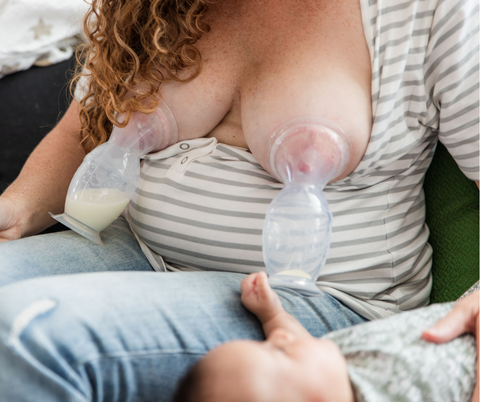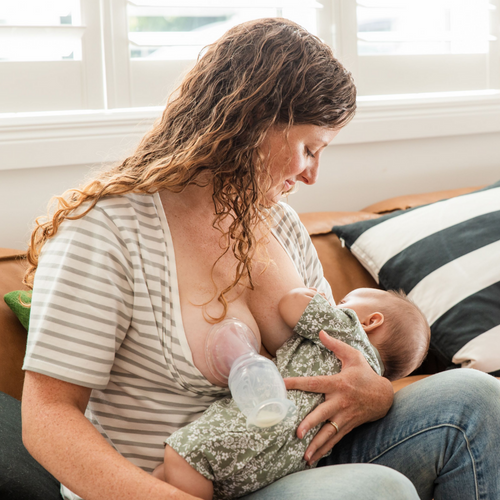At long last, the newest little love of your life has come into the world! While you look forward to the cherished memories you’ll make together, there’s also bound to be a million other things related to motherhood running through your mind.
One of the biggest decisions you’ll make is about how you will feed your baby. There’s no “best way” – whether you breastfeed and pump or use formula all depends on what you want, what your body can supply and what best suits your lifestyle.
We want to show new mums what Haakaa’s breast pumps can offer and how they can help in so many different ways. Our collective purpose is to make life easier for mothers so they can focus on their beautiful journeys with their babies, which has led us to compile this in-depth explanation on all things related to breast pumping!

Why should I use a breast pump?
Breast pumps can make life easier for mums for a wide variety of reasons. You might have to return to work while your baby is still on breast milk, and as a result, you need to build an extra stash. Perhaps you need to pump to relieve breast engorgement after your milk comes in. Maybe your baby is unable to latch or feed directly, or even the opposite – you might need to give your nipples a break from your bub’s mouth and give them time to heal! Whatever it is, if you feel pumping will benefit you and your baby, there’s no reason not to try it out.
Not only do breast pumps offer a range of conveniences to mothers, but they can also help maintain your milk supply. Your body makes milk based on how much it thinks your baby is feeding. When you pump, your breast pump mimics the suction of feeding to help you express – even if no milk comes out, the body receives signals that more milk needs to be made! Furthermore, pumping helps you look after your breasts as it drains any remaining breast milk left, minimising the chances of clogged milk ducts which can lead to nasty infections like mastitis.
Haakaa’s Generation 3 Silicone Breast Pump helps you express with the power of continuous suction, allowing your milk to flow directly into a detachable silicone bottle! It’s silent, discreet and portable, making it perfect for when you need to pump on the go as well as at home. Furthermore, you can multi-purpose the pump by swapping out the pump flange for another interchangeable attachment like our Sippy Bottle Spout, Anti-Colic Nipple, Feeding Spoon Dispenser or Sealing Disks.

When can I start using a breast pump?
It may take a couple of days after birth for your breast milk to come in. Before this time, you will express colostrum – a thick, sticky, yellow ‘first milk’ that will provide the foundations for your baby’s development. Because of its thicker consistency, colostrum is more difficult to express than breast milk, and you will only get a few drops of it at a time. If your baby is unable to nurse directly during the first few hours, it is best to hand express the colostrum for them. This is important because expressing within the first few hours after giving birth can help mothers to produce more milk in the early stages of their baby’s life!
TOP TIP: Our Silicone Colostrum Collectors are the perfect non-toxic and eco-friendly solution for collecting and feeding expressed colostrum to your baby! They can be used both antenatally and after birth and can be reused over and over again for a variety of other purposes. These beauties are made entirely of medical grade silicone and feature a soft silicone nib that your newborn can feed from!
If you have chosen to use a breast pump to complement your breastfeeding, it is widely recommended that you wait a few weeks after giving birth before you start pumping. This is because in those first few weeks, you and your baby work together to build your milk supply and establish a routine based on how much and how often bub feeds. If your baby is unable to breastfeed or you choose to pump exclusively, you should pump breast milk as soon as you can to better establish your milk supply.
When should I use my breast pump?
The easiest time for mothers to express milk using a breast pump is first thing in the morning. This is because your body’s milk-producing hormones have been busy working during the night while you were asleep! For the rest of the day, it’s best to express 30 minutes to 1 hour after feeding your bub. If you express milk just before a feed, there may be less for the baby – which is why it is recommended to wait an hour after pumping to feed. You can also use your pump to catch let-down from the other breast while your bub is feeding, which is something that many mums choose to do as it prevents any liquid gold from going to waste.
The amount you express and catch each day is different for each mother – every body is different! If you are concerned about whether your baby is receiving adequate nutrition, you can ask a lactation consultant or a breastfeeding specialist.

How can I express more milk when pumping?
Popular tips to help you express more milk when you’re pumping include massaging the breasts both before and during pumping. You can also stimulate milk flow by warming the breasts with a warm compress, like a flannel.
Oxytocin is an important hormone that helps mothers stimulate their let-down reflex. To release oxytocin, it’s essential to be relaxed, so choose to pump somewhere that is private and comfortable. Skin-to-skin contact with your baby can also help release oxytocin, so you may keep your baby close to you while pumping. If this isn’t possible, you can try looking at a photo or video of your baby, or smell an item of their clothing to raise your oxytocin levels.
You can also use a breast massager to encourage more let-down and help empty the milk from your breasts completely. The Haakaa Breast Massager is the ideal device for this – it’s small, portable, quiet and efficient. Each of the uniquely shaped sides assists lactation differently, and you can charge it easily using the USB cable included.

How long should my pumping sessions be?
Your pumping session should last around half an hour, or 2-5 minutes after the last drop of milk has come out. It is vital that you express until your breast is “empty” – this prevents clogged milk ducts which can cause painful lumps and even lead to mastitis (a nasty infection that inflames your breast tissue and causes flu-like symptoms).
How often should I pump breast milk?
If you’re a nursing mother, you should aim to express milk between 8 to 10 times a day. You do not need to extend the time between sessions to collect larger volumes of milk, as this only makes it more difficult to empty your breasts later on. It’s best to avoid going longer than 5-6 hours without pumping during the first few months – unfortunately, this means that you will probably have to wake up in the middle of the night to pump!
When pumping at night, try to wake up naturally rather than relying on setting an alarm. Milk yield tends to be better this way, instead of having your sleep disrupted.

How often should I clean my pump?
Sterilise your pump at least once a day. It’s super easy to sterilise our Haakaa pumps – because they are made entirely of food grade silicone, you can boil them in water for 2-3 minutes. Always rinse and dry thoroughly afterwards before storing.
How do I store pumped milk, and how long will it keep?
Your breast milk can be kept at room temperature for up to 4 hours but will last even longer in colder environments. In the fridge, it will last for up to two (2) days. It is best to keep it at the back of your refrigerator, where it's the coldest. You should not add fresh breast milk to cold expressed milk when you want to store them together – instead, wait until it has cooled to the same temperature.
TOP TIP: Use our Silicone Milk Storage Bags and Generation 3 Silicone Storage Containers (160ml) to safely store your milk in the fridge and protect it from any nasties. Remember to label each new batch with the current date, so you know when to use them by.

You can also freeze breast milk. You can keep it in a freezer box for 2 weeks, or in a separate door freezer for 2-6 months. You can even put it in the deep freeze for up to a year! Your milk may separate into layers when it is frozen, but once thawed, it will mix together again.
We recommend you use our Baby Food and Breast Milk Freezer Tray to freeze your milk in a super safe way. Our 100% food grade silicone ensures no harmful chemicals will leach into your liquid gold and makes it incredibly easy to get your frozen cubes out! You can also continue using our freezer trays to make healthy icy treats for your child once they have started solids.
How do I warm refrigerated breast milk and thaw frozen breast milk?
To warm breast milk from the fridge, pour it into the bottle you will use for feeding and place it in a cup, jug or bowl of warm water to bring it up to body temperature. You can test if it is too hot by squeezing a few drops onto the inside of your wrist.
To defrost frozen breast milk, keep it in the fridge or place it in a container of warm water until it thaws, then bring it up to body temperature. Do not use a microwave to heat breast milk as it can overheat and destroy the important, beneficial properties. It can also heat your milk unevenly, making it unsafe for your child. Once warmed, you should use breast milk immediately and throw away any leftovers. It is not safe to reheat or refreeze.

Motherhood can be an INCREDIBLY stressful time with so many things to juggle and remember! We understand the struggle, having gone through the journey ourselves, but we also know how rewarding it is at the end too. Hopefully, by passing on our tips and tricks for pumping, we can help make things easier for you so you can focus on the quality time spent with your bub. All the best, mamas! x

